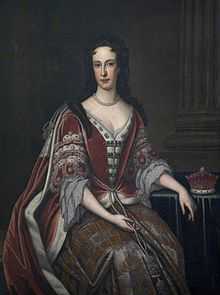Peregrine Bertie (senior)

Peregrine Bertie (ca. 1634 – 3 January 1701) was an English politician, the second son of Montagu Bertie, 2nd Earl of Lindsey.
He and his younger brother Richard left England after the death of Charles I. As a volunteer with the Duke of York in French service, he fought under the command of Turenne at the Siege of Arras. Lord Hatton reported seeing him in Paris that year, speaking in abusive terms of Charles II, and preparing to carry a message from the Duke of Buckingham to Cromwell. Thereafter, he disappeared from public life until the Restoration.[1]
He was commissioned a cornet in the King's troop, Royal Regiment of Horse Guards in 1661.[2] He may have unsuccessfully contested Stamford that year; his father, a royalist, joined with interest of the Hatcher family, Presbyterians, to oppose the borough's principal patron, the Earl of Exeter, but in the event it was Exeter's candidates, William Stafford and William Montagu that were returned.[1][3] The election was appealed on petition, but the election committee resolved that the franchise in Stamford was limited to freemen paying scot and lot only, and the election of Stafford and Montagu was upheld. After Stafford died in 1665, Bertie was returned at the ensuing by-election.[3]
Bertie was not a particularly active member, though certain invocations of parliamentary privilege by him suggest he was solicitous for the honour of the office. He first sat in the fifth session of the Cavalier Parliament, held at Oxford. On the day of his introduction to Parliament, he and his elder brother Lord Willoughby followed their brother-in-law Sir Thomas Osborne in voting against Lord Clarendon's measure for imposing an oath of nonresistance on the whole kingdom, which was thus unexpectedly defeated.[1][4] Later in the session, he sat on the committee for the act of attainder against Joseph Bampfield and other English republicans in Dutch service.[1] On 14 September 1667, he was made a lieutenant in Lord Hawley's troop of the Horse Guards.[2] During the same year, he was appointed to the commissions of assessment for Westminster and Lincolnshire.[1]
Bertie continued to be identified with the court party (i.e., the Tories) for the duration of the Cavalier Parliament. He was named to committees involved with the suppression of Catholicism and Nonconformism, but most of his Parliamentary activity in the early 1670s was related to the Bertie family's interests, or local affairs in Lincolnshire. In 1671, he was appointed to the commission on accounts for the loyal and indigent officers fund. In this role, he and John Grobham Howe were sent to Sir Edward Turnour, the Chief Baron of the Exchequer, in January 1673/4 to request that he speed the passage of Sir John Bennet's accounts for the fund at the Exchequer. In early February, he participated in the debate on the conduct Duke of Buckingham, suggesting that the Commons hear Sir Thomas Williams, who had reported Buckingham's condemnation of the King, before seeking concurrence from the House of Lords in their resolution condemning Buckingham.[1]
Soon after, Bertie married Susan Monins, daughter of Sir William Monins, 2nd Baronet, by whom he had three daughters:[5]
- Bridget Bertie (d. 23 March 1748), married on 14 April 1702 John Poulett, 1st Earl Poulett;
- Elizabeth Bertie, died unmarried;
- Mary Bertie, married first Anthony Henley, second Henry Bertie (d. 1735), her half-first cousin.
He was removed from the Westminster commission of assessment in 1674, and was made a commissioner of the Alienation Office in 1675.[1]
On 15 July 1676, after the death of Sir Francis Wyndham, Bertie succeeded him as captain of a Horse Guards troop.[2] He resigned his Horse Guards commission in June 1679 and was replaced by Thomas Lucy.[1][2]
He was first returned to the House of Commons in 1665, as Member of Parliament for Stamford, a seat he retained until 1679.
He was again returned as MP for Stamford in 1685, but after the Glorious Revolution, was returned for Westbury instead, a seat he held until 1695, when he stood down. A relatively minor political figure, he was, like the rest of his family, a Tory and a supporter of his brother-in-law, the Marquess of Carmarthen.[6]
References
- ↑ 1.0 1.1 1.2 1.3 1.4 1.5 1.6 1.7 Watson, Paula (1983). "BERTIE, Hon. Peregrine I (c.1635-1701), of Grimsthorpe, Lincs. and George Street, Westminster.". In Henning, B. D. The House of Commons 1660-1690. The History of Parliament Trust.
- ↑ 2.0 2.1 2.2 2.3 Dalton, Charles, ed. (1892). British Army Commission Registers v. 1. Eyre & Spottiswoode. pp. 4, 91, 190, 262.
- ↑ 3.0 3.1 Watson, Paula (1983). "Stamford". In Henning, B. D. The House of Commons 1660-1690. The History of Parliament Trust.
- ↑ Courtenay, Thomas P. (1838). Lives of Eminent British Statesmen v. 5. Green & Longmans. p. 199.
- ↑ Burke, Bernard (1866). A Genealogical History of the Dormant, Abeyant, Forfeited, and Extinct Peerages of the British Empire. London: Harrison. p. 51.
- ↑ Watson, Paula; Gauci, Perry (2002). "BERTIE, Hon. Peregrine I (c.1634-1701), of York Buildings, Westminster, Mdx. and Waldershare, Kent.". In Hayton, David; Cruickshanks, Eveline; Handley, Stuart. The House of Commons 1690-1715. The History of Parliament Trust.
| Parliament of England | ||
|---|---|---|
| Preceded by William Stafford William Montagu |
Member of Parliament for Stamford 1665–1679 With: William Montagu 1665–1677 Henry Noel 1677 Charles Bertie 1678–1679 |
Succeeded by Sir Richard Cust, Bt William Hyde |
| Preceded by Sir Richard Cust, Bt William Hyde |
Member of Parliament for Stamford 1685–1689 With: Charles Bertie |
Succeeded by Charles Bertie William Hyde |
| Preceded by Richard Lewis James Herbert |
Member of Parliament for Westbury 1689–1695 With: Richard Lewis |
Succeeded by Richard Lewis Robert Bertie |